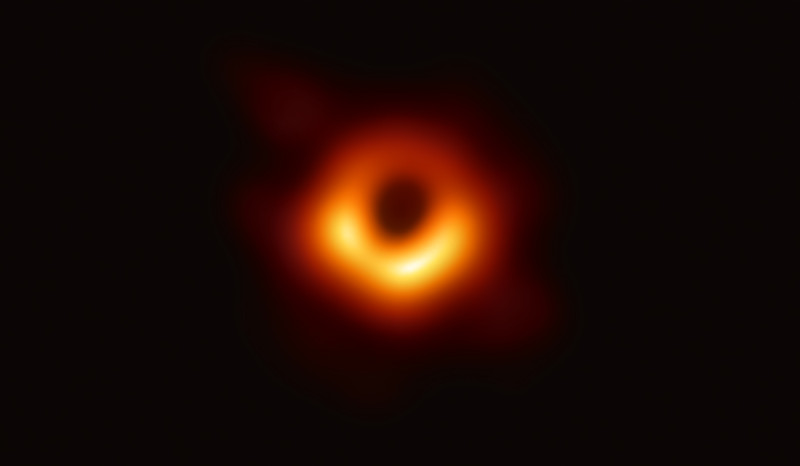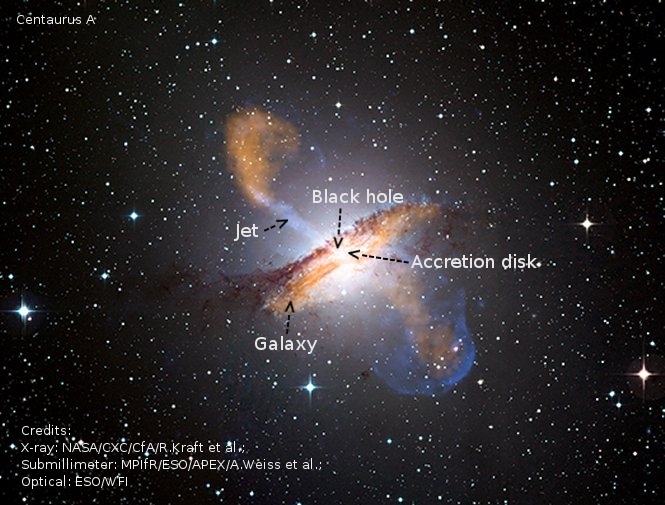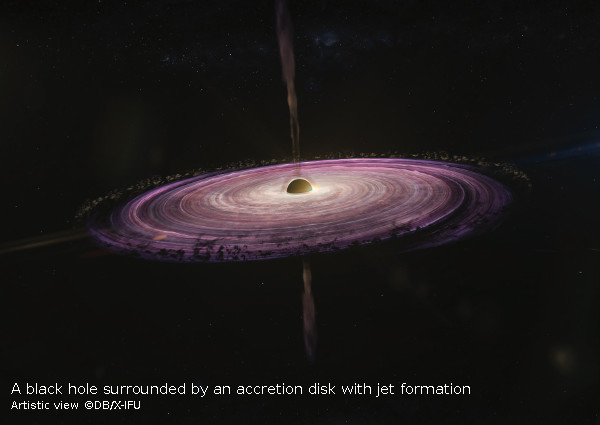 First image of a black hole! It was obtained by the Event Horizon Telescope (EHT) Collaboration from observations of the center of the galaxy Messier 87 (M 87). The image shows a bright ring formed as light bends in the intense gravity around a black hole that is 6.5 billion times more massive than the Sun. The central dark region represents the shadow of the black hole. The asymmetry in brightness in the ring can be explained in terms of relativistic beaming of the emission from a plasma rotating close to the speed of light around the black hole. This image provides the strongest evidence to date for the existence of supermassive black holes.
First image of a black hole! It was obtained by the Event Horizon Telescope (EHT) Collaboration from observations of the center of the galaxy Messier 87 (M 87). The image shows a bright ring formed as light bends in the intense gravity around a black hole that is 6.5 billion times more massive than the Sun. The central dark region represents the shadow of the black hole. The asymmetry in brightness in the ring can be explained in terms of relativistic beaming of the emission from a plasma rotating close to the speed of light around the black hole. This image provides the strongest evidence to date for the existence of supermassive black holes.
 Black holes are associated with the most energetic phenomena in the Universe, since the Big Bang: (i) gamma-ray bursts, (ii) relativistic jets from active galactic nuclei, and (iii) gravitational waves.
Black holes are associated with the most energetic phenomena in the Universe, since the Big Bang: (i) gamma-ray bursts, (ii) relativistic jets from active galactic nuclei, and (iii) gravitational waves.
The black holes are theoretical predictions of Einstein's theory of general relativity, being probably one of the most exciting topics in astrophysics. Observational data support the idea that black holes exist in our Universe. For instance, it is believed that a supermassive black hole (weighing up to billions of times the mass of the Sun) resides at the center of each galaxy, whereas stellar-mass black holes coexist in binary systems within galaxies.
 The black hole can be surrounded by an accretion disk which supplies the central black hole with plasma and magnetic fields. A small fraction of the plasma in the disk can be diverted through magnetohydrodynamic processes into jets that propagate at relativistic speeds out to large distances from the host galaxy. (Alternatively, the jets can be powered by the rotational energy of the black hole. The relativistic jets are observed in the whole electromagnetic spectrum, mostly in the radio domain, where their emission is considered to be synchrotron radiation from electrons and positrons, as well as inverse Compton radiation. The most noticeable processes associated with propagation and emission of the jets are the internal and external plasma shocks and instabilities and the magnetic reconnection. The jets from black holes in active galactic nuclei (AGN) can also be sites of acceleration of ultra-high-energy cosmic rays (UHECRs), which are the highest energy particles known in the Universe. These cosmic rays are particles with energies up to 1021 eV, which is billions of time the maximal energy that can be obtained for particles accelerated through the experiments at CERN.
The black hole can be surrounded by an accretion disk which supplies the central black hole with plasma and magnetic fields. A small fraction of the plasma in the disk can be diverted through magnetohydrodynamic processes into jets that propagate at relativistic speeds out to large distances from the host galaxy. (Alternatively, the jets can be powered by the rotational energy of the black hole. The relativistic jets are observed in the whole electromagnetic spectrum, mostly in the radio domain, where their emission is considered to be synchrotron radiation from electrons and positrons, as well as inverse Compton radiation. The most noticeable processes associated with propagation and emission of the jets are the internal and external plasma shocks and instabilities and the magnetic reconnection. The jets from black holes in active galactic nuclei (AGN) can also be sites of acceleration of ultra-high-energy cosmic rays (UHECRs), which are the highest energy particles known in the Universe. These cosmic rays are particles with energies up to 1021 eV, which is billions of time the maximal energy that can be obtained for particles accelerated through the experiments at CERN.

